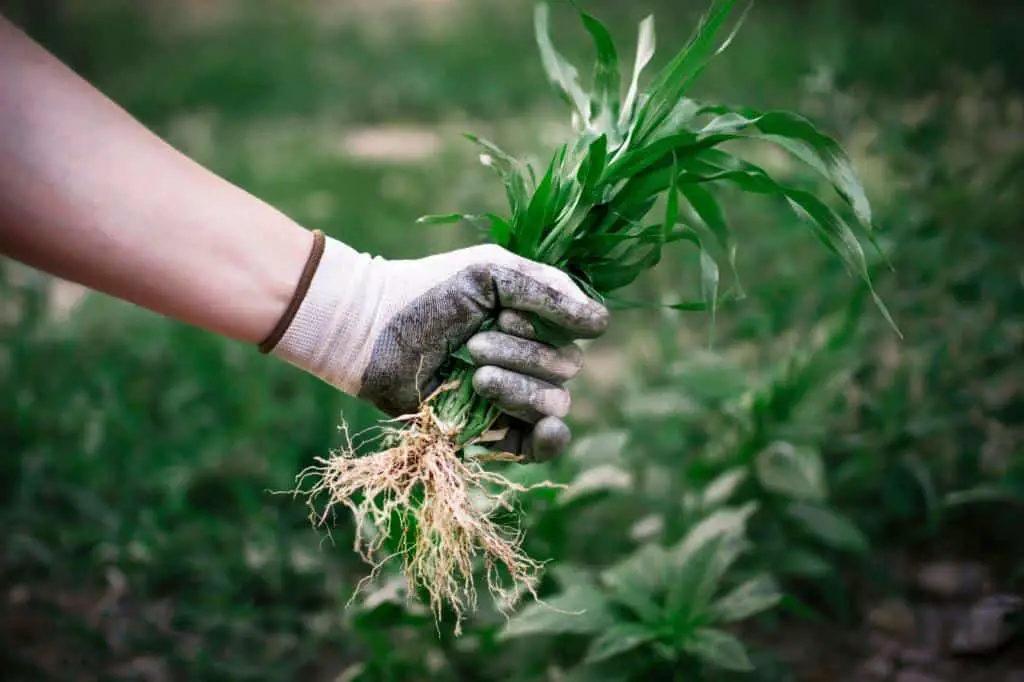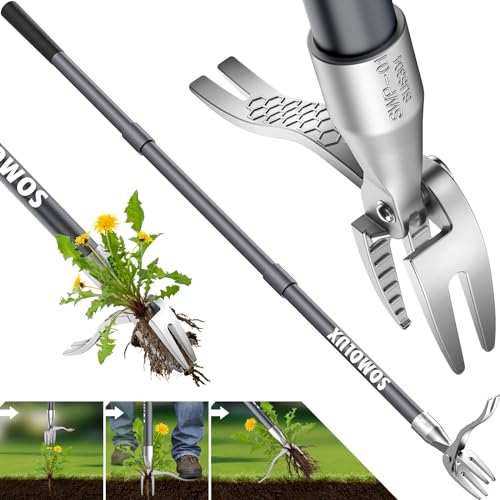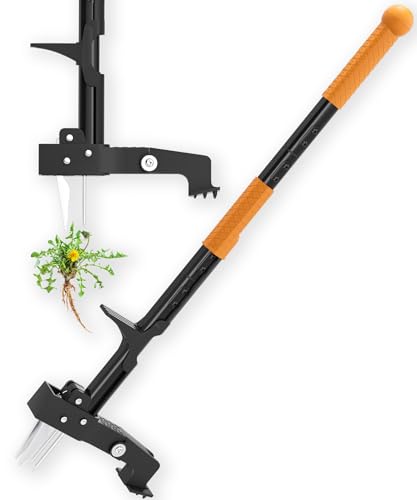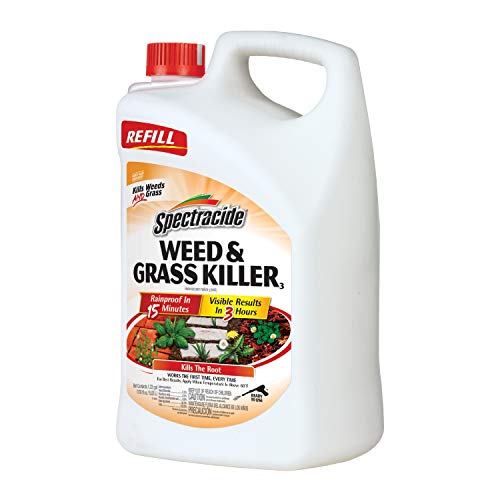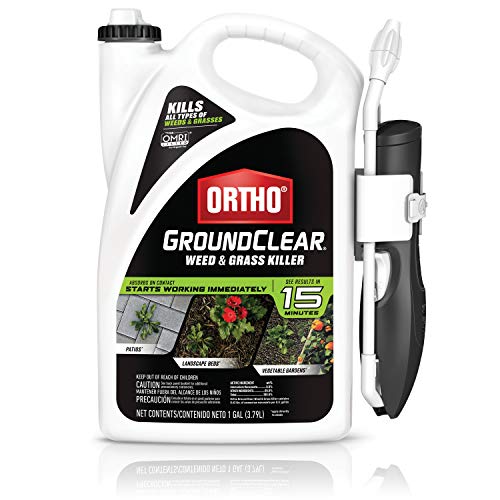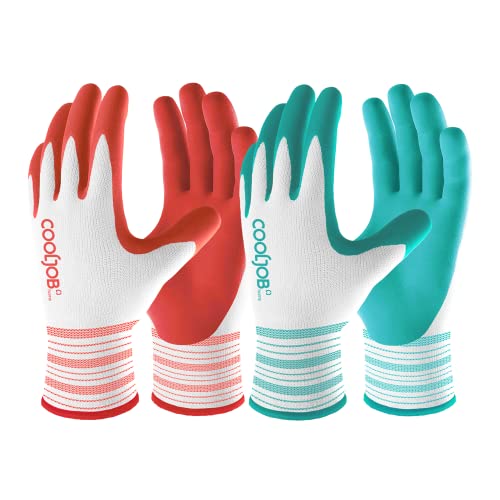When weeds are taking over your lawn and causing damage to your precious turf, it’s time to take action.
Pulling weeds manually is usually the best option, especially if you have soft leaf buffalo grass that is sensitive to herbicides.
The key is to tackle the problem as soon as possible when the weeds are small, and their roots are weak. This way, you can prevent them from competing with your grass for water and nutrients.
Below, we provide valuable tips on how to effectively pull weeds from your lawn and prevent them from coming back. We’ll guide you through choosing the right tools and explain when is the perfect time to remove those pesky intruders.
Plus, we’ll share tips on protecting your hands during the process.
Get ready to reclaim your beautiful lawn by pulling weeds like a pro!
Why Weeding Is Important
First, let’s talk about why weeding is so important for your yard.
Weeds are notorious for stealing valuable resources from beneficial plants. They have aggressive root systems that can quickly spread and take over your lawn if left unchecked.
As they grow, they compete with your grass for water and nutrients, resulting in weak and patchy areas.
Addressing weed problems as soon as possible can also significantly reduce the time spent weeding in the long run.
You can easily remove weeds from the soil without disturbing the surrounding grass by pulling them when they’re small and their roots are weaker. It not only saves you time but also prevents future weed growth.
Choosing the Right Tools

Equipped with the right tools, uprooting stubborn weeds from your turf becomes a breeze. These specialized instruments effortlessly dig into the soil and extract pesky intruders at their very roots.
When it comes to choosing the perfect tool for weed pulling, there are several options available that cater to different needs and preferences.
The most common weed puller tool is the hand-held weeder with a narrow, forked end. This tool allows you to dig down around the weed’s roots and reach into small spaces, such as sidewalk cracks or between landscape rocks. It provides excellent leverage and control, ideal for removing weeds with long roots like dandelions or bindweed.
If kneeling or crouching is challenging for you, standing weeding tools are an excellent alternative. These tools have a similar forked end but come with long handles that allow you to twist them into the ground without having to bend down. They provide added convenience and ease while effectively removing weeds from your lawn.
Preventing Weed Growth
To ensure your lawn remains weed-free, it’s essential to take proactive measures that discourage the growth of unwanted intruders.
Here are some tips for preventing weed growth in your lawn:
- Use pre-emergent herbicides: Applying a granular or liquid pre-emergent herbicide can create a barrier in the soil that prevents weed seeds from germinating. These herbicides should be reapplied every 12 weeks to maintain their effectiveness.
- Avoid disturbing weed seeds: When digging up sections of your lawn or working in garden beds, be careful not to disturb dormant weed seeds. Disturbing the soil can bring these seeds to the surface, where they have access to light and moisture, increasing the risk of germination.
- Maintain a healthy lawn: A well-maintained lawn with thick, healthy grass is less likely to have issues with weeds. Regularly mowing, fertilizing, and watering your lawn will help it compete against weeds for nutrients and water.
- Mulch perennial beds: Adding a layer of organic mulch around plants in your garden beds can help prevent weed growth by blocking sunlight from reaching the soil. Be sure to push aside the mulch when planting new seedlings or transplanting plants.
Natural Weed Control Methods
While chemical herbicides can be effective, they can potentially harm the environment. Using natural weed control methods, you can maintain a healthy lawn without harmful chemicals.
One effective method is pulling weeds by hand. This method allows you to remove weeds from the root, ensuring they won’t regrow. It’s best to do it after rain or watering when the soil is loosened and easier to work with.
Use tools like a spade, hoe, or weed puller to assist in removing stubborn weeds. Remember to tease the soil away from the roots before pulling the plants straight up in one slow, smooth motion.
For certain types of weeds like Nutgrass, Onion Weed, and Soursob, it’s best not to use a weed puller as they have nuts, tubers, or rhizomes that can spread underground and develop new plants. Instead, use a spade for these types of weeds.
After pulling each weed, make sure to dispose of them properly in a waste bag or bucket. This prevents any seeds or rootlets from falling back into your lawn.
Another natural option is using homemade weed killers, such as vinegar or boiling water. These solutions can effectively kill weeds when applied directly at their base without harming other plants.
Additionally, maintaining a healthy lawn through regular mowing and proper watering can help prevent weed growth by creating unfavorable conditions for weed seed germination.
Chemical Weed Control Options

If push comes to shove, you may consider chemical weed control options. Chemical weed control products, such as herbicides, can be used to spot-treat and kill weeds before pulling them out.
Nevertheless, it’s paramount to exercise caution when using chemical weed killers. These products contain active ingredients that can have detrimental effects on the environment if not used properly. They can linger in the water and make it toxic to wildlife, and they can also be harmful to pets and children.
When using chemical weed control options, carefully follow the manufacturer’s instructions. It includes wearing gloves and a mask during the process and avoiding windy days for application.
Here are the potential risks associated with chemical weed control options:
- Adverse effects on wildlife: Overuse or improper use of herbicides can potentially harm local flora and fauna, upsetting the ecological balance.
- Negative impact on microbial population: Herbicides may initially cause a decline in soil microbial populations, key players in soil fertility and health.
- Health hazards to applicators: Unprotected or untrained workers handling the compounds can suffer from harmful side effects, such as skin irritation, vomiting, nail damage, nose bleeding, and eye irritation.
- Crop phytotoxicity: Improper herbicide usage can cause phytotoxicity (plant poisoning) which might negatively affect crop yield and quality.
- Development of herbicide-resistant weeds: Repeated use of the same herbicide may lead to the development of herbicide-resistant “superweeds.”
- Damage to neighboring crops through spray drift: Spray drift can inadvertently damage crops not initially targeted for herbicide application.
- Shifts in weed balance: Successful control of certain weed species might pave the way for the growth of new problematic species.
Protecting Your Hands
When dealing with weeds, protecting your hands is essential. High-quality gloves provide the necessary barrier to prevent skin damage and allow you to tackle those pesky invaders without hesitation.
Here are some reasons why investing in good gloves is important:
- Safety: Weeds can have thorns, spines, or prickly leaves that can cause cuts, scratches, or allergic reactions on your hands. Wearing gloves protects your skin from these potential hazards and reduces the risk of infection.
- Comfort: Pulling weeds can be a labor-intensive task that requires a firm grip. Gloves with padded palms or reinforced fingertips provide extra cushioning and enhance your grip strength, making the job more comfortable.
- Durability: High-quality gloves are made from durable materials like leather or synthetic fabrics that resist punctures and tears. These gloves can withstand repeated use without wearing out quickly, saving you money in the long run.
- Chemical protection: Some weed killers contain harsh chemicals that can irritate or burn your skin. Gloves are a barrier between these chemicals and your hands, preventing accidental contact and keeping you safe.
- Hygiene: Weeds often carry dirt, bacteria, and other contaminants. Wearing gloves prevents direct contact with these substances, minimizing the risk of transferring them to other areas of your garden or inadvertently spreading diseases.
Seeking Professional Help
Hiring a professional can be a game-changer if you want to quickly conquer your weed problem and restore the beauty of your garden. Lawn care services have the expertise and experience to deal effectively with stubborn weeds that may be difficult for homeowners to eradicate on their own.
Professional lawn care services have extensive knowledge about different types of weeds, their growth patterns, and effective removal methods. They can accurately identify specific weeds in your lawn and implement tailored strategies for effective eradication.
At the same time, hiring professionals saves you valuable time that you would otherwise spend pulling weeds manually or experimenting with different DIY methods.
Additionally, professional lawn care services offer long-term solutions by addressing the underlying causes of weed growth. They can assess factors such as soil quality, irrigation practices, and overall lawn health to develop a comprehensive weed control plan tailored to your specific needs.
When selecting a lawn care service, choose a reputable company that is licensed and insured. Search for professionals who have experience dealing with weed problems similar to yours and ask for recommendations from friends or neighbors who have used their services before.
The Bottom Line
Pulling weeds from your lawn is vital to maintain a healthy and beautiful yard. It would be best to resolve the issue as soon as you spot the first sign of infestation.
By addressing weed problems promptly and using the right tools, you can effectively remove them without causing damage to your lawn.
It’s important to prevent weed growth by regularly mowing and taking measures to avoid seeds or rootlets from falling back into the lawn. Natural weed control methods are preferred, but if necessary, chemical options should be used carefully following safety instructions.
Remember to protect your hands during the process and seek professional help if needed. Good luck!
Frequently Asked Questions
How often should I pull weeds from my lawn?
You should pull weeds from your lawn regularly to prevent them from spreading and competing with your grass for water and nutrients. Removing weeds when they’re small and have weaker roots is best.
Can I use homemade weed killers instead of chemical herbicides?
Yes, you can. Homemade weed killers like vinegar, boiling water, salt, or baking soda can effectively treat weeds and are safer for the environment.
What are some common mistakes to avoid when pulling weeds?
When pulling weeds, avoid these common mistakes:
- Pulling only the top of the weed without removing the roots.
- Disturbing the soil and bringing dormant weed seeds to the surface.
- Not using gloves to protect your hands.
Is it necessary to wear protective clothing when pulling weeds?
Yes, wearing protective clothing when pulling weeds is necessary to protect yourself from infections. Wearing gloves can protect your hands from potential irritants or thorns, and wearing long sleeves and pants can prevent skin contact with harmful plants or chemicals.
Are there any specific techniques for removing deep-rooted weeds?
To remove deep-rooted weeds, start by loosening the soil around the weed with a garden fork or spade. Then, grip the base of the weed and slowly pull it out, making sure to remove as much of the root system as possible.
Was it helpful?

Enamored with the world of golf Jack pursued a degree in Golf Course Management at THE Ohio State University. This career path allowed him to work on some of the highest profile golf courses in the country! Due to the pandemic, Jack began Inside The Yard as a side hustle that quickly became his main hustle. Since starting the company, Jack has relocated to a homestead in Central Arkansas where he and his wife raise cattle and two little girls.

